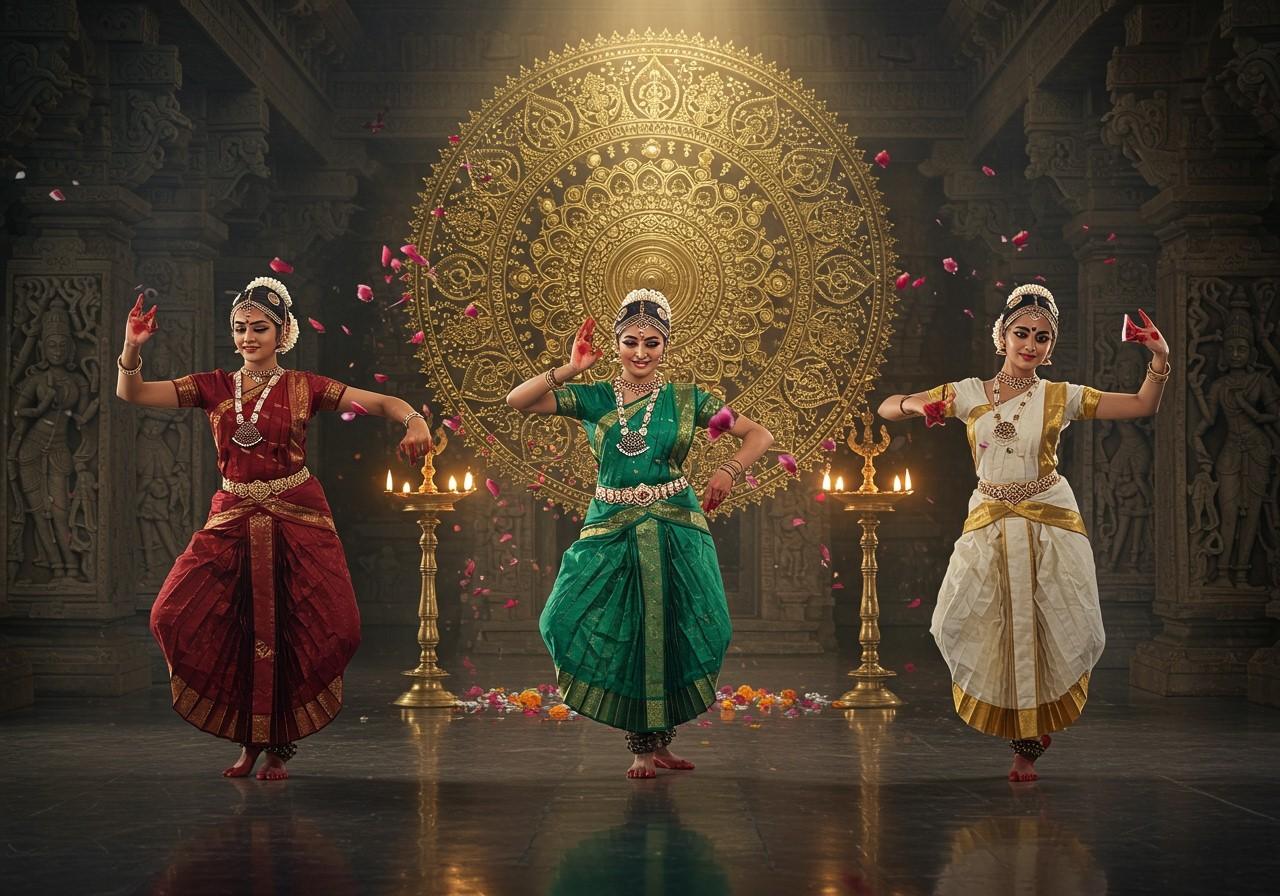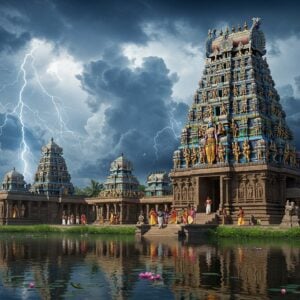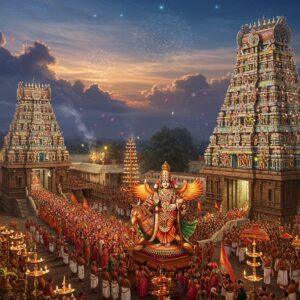
India’s temple dances weave a vibrant tapestry of cultural heritage, each style unique to its region and deeply intertwined with religious practices. Performed in temples across the land, these dances are not mere artistic expressions; they are spiritual and ritualistic offerings, embodying devotion and reverence. This blog explores the significance of various temple dance forms, focusing on specific styles like the traditions of Jagannath Temple, Kerala, and Thanjavur. We’ll delve into how these dances reflect the cultural ethos of their regions and continue to be a living tradition, cherished by communities who value heritage and authenticity.
A Journey Through Time: The History of Temple Dances
The history of temple dances in India stretches back to ancient times, when dance was an intrinsic form of worship. Dedicated temple dancers, known as Devadasis, devoted their lives to serving the deities through their art. Royal courts recognized the significance of these dances, offering patronage that led to their development and refinement. While colonial rule impacted these traditions, revival movements in the 20th century played a crucial role in their preservation. The close connection between temple dances and classical Indian dance forms showcases how these sacred traditions have influenced and been preserved in classical styles. Want to learn more about the rich history of Indian temple dance? Check out this insightful article: Annapoorneshwari Temple: Visit, Accommodation & Travel Attractions.
Jagannath Temple Dance: Odisha’s Sacred Rituals
The Jagannath Temple in Puri, Odisha, is renowned for its unique dance traditions. The Gotipua dance holds particular significance, traditionally performed by young boys dressed as female dancers, deeply connecting with the temple’s rituals. The Mahari dancers, the female temple dancers, also played an integral role in ceremonies. These traditions have profoundly influenced Odissi, one of India’s celebrated classical dance forms. Religious festivals at the Jagannath Temple prominently feature these dances, keeping the traditions alive and vibrant.
Kerala Temple Dance: Kathakali and Mohiniyattam’s Grace
Kerala’s temple dance traditions are known for their ritualistic and dramatic forms, most notably Kathakali and Mohiniyattam. These dances originated in temple rituals and evolved into captivating theatrical performances. They hold immense cultural significance in festivals like Onam and Vishu. Temples serve as vital cultural hubs for training and performances, playing a crucial role in preserving these beautiful art forms. Kerala’s temple dances have influenced Bharatanatyam and continue to be an integral part of temple rituals. Delve deeper into the world of Annapoorneshwari temples across India: Annapoorneshwari Temples in India: Exploring the Goddess’s Diverse Forms.
Thanjavur Temple Dance: Bharatanatyam’s Elegance
Thanjavur, in Tamil Nadu, boasts a rich heritage of temple dances, closely linked with the graceful Bharatanatyam. The Thanjavur Maratha rulers were great patrons of these traditions, contributing significantly to their flourishing. The renowned Thanjavur Quartet played a pivotal role in shaping Bharatanatyam into the classical form we know and love today. Temple dances are integral to religious rituals and festivals like the Natyanjali festival. The architectural grandeur of Thanjavur’s temples is reflected in the aesthetic elements of Bharatanatyam, creating a harmonious blend of art and architecture.
The Cultural and Spiritual Heart of Temple Dances
Temple dances beautifully bridge the spiritual and artistic realms. They are not mere performances; they are offerings to the deities, each movement a prayer. The discipline required is immense, with dancers dedicating years to training, embodying devotion in every gesture and expression.
The Symbolic Language of Dance
The language of temple dance is rich in symbolism. Each hand movement, known as a mudra, conveys a deep meaning, telling a story or representing an emotion. These gestures are steeped in tradition, carrying messages that transcend words, connecting the dancer and the audience to a deeper spiritual understanding.
Community and Tradition: Keeping the Flame Alive
Communities play a vital role in preserving these precious traditions. Knowledge is passed down through generations, fostering a sense of shared cultural pride. Festivals and ceremonies provide platforms for these dances, bringing people together in celebration and reverence, strengthening the bonds of community and faith. Learn more about the nine forms of Narasimha at Ahobilam: Ahobilam’s Nine Narasimha Forms: A Complete Guide. And for those planning a pilgrimage, here’s a guide to accommodation facilities at Ahobilam: Ahobilam Pilgrim Accommodation Facilities Guide.
Kerala Temple Dance: Kathakali and Mohiniyattam’s Unique Expressions
Kathakali, with its dramatic storytelling, elaborate costumes, and vibrant makeup, transports audiences to the world of Hindu epics. Performers embody characters with intense expressions and precise movements, bringing ancient tales to life. Mohiniyattam, in contrast, is a picture of grace and fluidity, showcasing femininity with gentle sways and soft gestures. Both dance forms hold a special place in Kerala’s cultural landscape, captivating audiences during festivals like Onam and Vishu.
Thanjavur Temple Dance: Bharatanatyam’s Royal Legacy
Bharatanatyam flourished under royal patronage in Thanjavur, refined by the legendary Thanjavur Quartet. The temples of Thanjavur are not just architectural marvels; they are living cultural hubs where Bharatanatyam continues to thrive, connecting the past with the present.
Jagannath Temple Dance: Odissi’s Lyrical Grace
Odissi, rooted in the Jagannath Temple, is known for its lyrical grace and intricate movements. The Gotipua dancers, young boys dressed as women, perform complex routines, while the Mahari dancers have historically played a crucial role in temple rituals. These traditions have shaped Odissi into a classical dance form revered for its beauty and spiritual depth.
A Living Tradition: Embracing the Future
Temple dances are living traditions, constantly adapting while staying rooted in their rich history. They are a link between generations, allowing us to experience culture and spirituality firsthand. As these dances evolve, they retain their essence, reflecting the vibrant tapestry of Indian heritage.
Poojn.in: Connecting You to Temple Dance Traditions
At Poojn.in, we are passionate about supporting your connection to India’s sacred dance traditions. We offer a curated selection of authentic ritual items and dance accessories, designed to bring the divine presence of these art forms into your life.
- Pure brass ghungroos (dance anklets): Enhance your classical dance practice with the authentic sound of these beautifully crafted anklets. These ghungroos are made with high-quality brass, ensuring a clear and resonant sound. They are available in various sizes to fit dancers of all ages and levels of experience.
- Traditional dance practice sarees: Embrace the elegance and comfort of traditional dance sarees in cotton and silk. Our sarees are specially designed for dance practice, allowing for ease of movement and a graceful flow. They are available in a variety of colors and designs, reflecting the rich traditions of different dance forms. Explore our traditional sarees here.
- Temple-style dance jewelry sets: Adorn yourself with exquisite temple-style jewelry sets that complement your dance attire. Our jewelry sets are crafted with intricate details, reflecting the rich artistry of traditional temple jewelry. They are made with high-quality materials, ensuring durability and beauty.
- Brass lamps and diyas: Illuminate your dance performances with the warm glow of brass lamps and diyas. These traditional lamps create a sacred ambiance, enhancing the spiritual aspect of your dance. They are available in various sizes and designs, perfect for both home practice and stage performances.
- Authentic musical instruments: Find the perfect musical accompaniment for your dance practice with our selection of authentic instruments. We offer a range of instruments, from tablas and mridangams to flutes and sitars, all crafted by skilled artisans. Browse our musical instruments here.
Quality and Convenience: The Poojn.in Promise
- Quality certification: Rest assured that all our products are of the highest quality, meeting traditional standards and specifications.
- Pan-India delivery: We deliver across India, bringing the essence of temple dance traditions to your doorstep.
- Expert guidance: Our team of experts is available to provide personalized guidance on product selection, ensuring you find the perfect items for your needs. We understand the nuances of each dance form and can help you choose the right accessories and ritual items.
- Secure packaging: We take utmost care in packaging your orders to ensure that they reach you in perfect condition. Each item is carefully wrapped and protected to prevent any damage during transit.
- Easy returns: We offer hassle-free returns for your peace of mind. If you are not completely satisfied with your purchase, you can easily return it for a refund or exchange.
Contact us for all your dance-related ritual needs:
Phone: 03369029784
WhatsApp: 9476142738
Website: www.poojn.in
Embracing the Heritage, Embracing the Future
Temple dances hold a special place in the heart of Indian culture, seamlessly blending artistry, spirituality, and tradition. They are more than just performances; they are expressions of deep devotion and cultural pride. As we embrace this rich heritage, we celebrate our past and look towards the future. Explore the beauty of brass murtis of deities, Ladoo Gopal murtis, and Lakshmi murtis at Poojn.in.
From attending live performances at temples and cultural festivals to learning the stories and meanings behind each dance, there are countless ways to connect with these captivating art forms. By supporting and participating in these traditions, we ensure their vibrancy for generations to come.
In our fast-paced world, temple dances offer a moment of reflection and connection. They remind us of the beauty of tradition and the power of dance to communicate emotions and stories beyond words. Let us continue to cherish and honor these living traditions, ensuring they remain a vibrant part of our cultural landscape.
FAQs on Temple Dance Across India
What is the history of Jagannath temple dance?
Jagannath temple dance, also known as Odissi, has ancient roots in the Jagannath Temple of Odisha. Historically performed by Devadasis, it served as a form of worship and offering to the deities.
How does Kerala temple dance differ from other styles?
Kerala temple dance, with forms like Kathakali, is renowned for its elaborate costumes, makeup, and dramatic storytelling, often depicting scenes from Hindu epics.
What makes Thanjavur temple dance unique?
Thanjavur is closely associated with Bharatanatyam, a classical dance form known for its grace, precision, and intricate footwork combined with expressive hand gestures, narrating tales of devotion.
Are there any specific rituals associated with temple dances?
Yes, temple dances frequently begin with ritualistic offerings to the gods, incorporating specific steps and gestures to invoke blessings and demonstrate reverence.
Why is temple dance important in Indian culture?
Temple dance serves as a vital link between spirituality and art, preserving ancient traditions and offering a powerful medium for expressing devotion through movement and music.
Can anyone learn temple dance styles?
Absolutely! With dedication and practice, anyone can learn temple dance styles. Numerous dance schools across India offer instruction, playing a crucial role in preserving this cultural heritage.
What role do costumes play in temple dance?
Costumes are integral to temple dance, enhancing the storytelling and visual appeal. The vibrant colors, jewelry, and accessories reflect the character being portrayed, adding depth and meaning to the performance.
How has temple dance evolved over time?
Temple dance has evolved from a purely religious practice to a celebrated art form performed on stages worldwide. While maintaining its traditional roots, it has incorporated modern elements to resonate with broader audiences.
Discover a wide range of puja essentials and cultural products on poojn.in. We offer pan-India delivery and are committed to providing authentic and high-quality items for all your spiritual needs.


